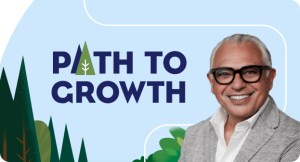He has launched brands, like Club Monaco and Joe Fresh, that have become case studies in what it takes to grow a thriving business, but the past 18 months have redefined what success means to Joe Mimran.
Speaking at Salesforce Canada’s first Path To Growth event of 2021 recently, the fashion entrepreneur reflected upon the unique challenges brought on by the pandemic and how they have affected the priorities of business leaders. While revenue and margin are still critical, he suggested they are far from the only ones.
“Success is coming out of this situation healthy, and ensuring that everybody that you work with and all the people around you are mindful and understanding of what they’ve just gone through,” Mimran said.
Others on the Path To Growth panel echoed the same sentiment. Zahra Al-Harazi, a purpose-driven leadership expert & entrepreneur with Skillit, noted that two years ago her life was “frantic at best,” where she was not living in the same city as her husband and not eating well.
“I learned to calm the madness,” she said, adding that paying greater attention to self-care is an overlooked driver of business growth because of how it can deepen their connection with their target audience. “The stress we have is the same stress that our customers have.”
Salesforce global innovation evangelist Brian Solis agreed.
“Success moving forward from a business standpoint is really about knowing customers and understanding with empathy how they were impacted by the pandemic,” he said. “There’s a lot to learn, and an opportunity to build relationships in ways that we didn’t really think to value before.”
Some of those opportunities include:
1. Enhancing Customer Experiences Through Digital Technology And Data
According to a survey of more than 1,500 Canadians conducted by Salesforce this past Spring, more than three-quarters, or 76 per cent expect customer service online to be as good as or better than the in-store experience.
This only comes when businesses build customer-centricity into every aspect of the experiences they provide. At Honda Canada, for example, the company had long provided a portal for owners to register their vehicles.
Given the pressures they have faced throughout the pandemic, however, Honda Canada realized the portal needed to offer more contextual information to make it easier to use. According to Jaldeep Pandya, the auto maker’s senior manager of business transformation, this meant focusing on what customers were asking for, rather rather than what Honda Canada thought was important to them.
“The car owners loved the brand, but we were not getting the same love
on our digital experience platforms,” he said.
The first step was in renaming the owner’s portal as MyGarage, which meant it could be brand-agnostic whether customers were buying a car, a motorcycle or other vehicle. Next, the company made it easier to facilitate online payments and provided greater visibility into information around recalls, service and warranties. As a result, registrations have since grown from more than 350% from last year.
If it’s difficult to understand what a great customer experience should look like in your industry, Solis offered a helpful way of describing it.
“Customer experience is a human response to a moment,” he said. “It’s important to remember that when we have the attention of our customers that it’s a gift, and we should do something with that beyond a transaction.”
2. Build Loyalty Based On Trust And Values
Using experience as a differentiator is critical in part because customers have more choice of where to shop than ever before. In fact, Salesforce Canada research showed nearly half, or 43 per cent of Canadians surveyed aged 18 to 34 are less loyal to brands today than they were one year ago.
The traditional approach to driving customer loyalty has included discounts and points programs. Those can still work, but Solis advised thinking of “loyalty” as where a business and a customer’s values align.
Mimran, who recently launched a new baby and toddler brand called Rise Little Earthling, is demonstrating how that principle works in practice. Besides offering great apparel, Rise Little Earthling is also building an online community for young moms, and has produced a series of podcasts with affirmations for young children. The idea is to not only clothe children, but help them become future citizens of the world.
“Leading with values is at the root of this brand,” he said. “The world is huge today, and the audience wants to identify with the brand not just from an aesthetic standpoint, but all the values of that brand.”
Aligning on values builds trust, Solis added, especially when it becomes apparent throughout the experience. Pandya said Honda Canada has seen the same thing, where loyalty that used to be based on the popularity of a car brand is now shifting to how the auto maker supports them over the six or seven years they own their vehicle.
“It’s about how to engage throughout that life experience (as a customer) so the next time when you think about us, it’s only us and no one else,” he said.
3. Develop Processes and Skills To Deliver Success From Anywhere
Not surprisingly, the shift to digital channels amid lockdown is having long-term impacts. Salesforce Canada’s survey showed more than eight in 10 Canadians, or 80 per cent, expect to buy a greater variety of products online.
There’s a similar change happening within companies, though, where business leaders are recognizing that a lot of work can happen outside of the office at least some of the time.
Al-Hazari stressed that remote work won’t drive growth if companies simply tell employees to stay home. Instead, she called for training and development programs that will help everyone adapt to new digital processes.
“Companies should craft a talent strategy that develops digital, cognitive, emotional, social skills,” she said. “That means doubling down on learning budgets and re-skilling and up-skiling their workforce.”
Some of these skills might include how to foster creativity among a virtual team, Al-Hazari added. This has been something Honda Canada has focused on as well, according to Pandya.
“We’ve been trying to make more time for ‘creative destruction,’ to a certain degree,” he said. “Unless you play and tinker with ideas and strategies, it’s hard to say, ‘Yes, you can move to the next level’ as a business.”
Solis said a remote workforce should be led with a spirit of ‘human-centred connectedness, where team members feel empowered and are nurtured to treat customers with empathy.
“In order to ensure greater customer experiences, you need to have that greater employee experience as well,” he said.
The good news is that when companies get this area right, the technologies are there to help them continue their path to growth, Mimran said.
“You might think working from home would be a big challenge in our sector, especially selling, because you have to feel fabrics and look at them,” he said. “With all of this 3D modelling going on now, it’s amazing how we really haven’t missed a beat in terms of showing products, even in international markets. As long as technology is keeping up with the speed of change, we’re finding ways to figure it out.”

























